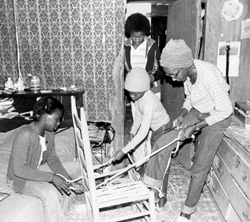Table of Contents
Folk Regions
Three Ethnic Perspectives
Folk Music of the Florida Parishes
People of the Florida Parishes
In Retrospect

People of the Florida Parishes: Their Arts, Crafts, and Traditions
Craft Traditions
Basket Weaving
Booker T. Owens, Angie
Booker T. Owens was born in 1914 in Maryland County, Mississippi. Both his father, Reverend Alton Owens, and his mother, Mary Owens, were born and raised in the same county. Booker T. Owens moved to Angie, where his wife was born and raised, around 1965. The Owenses grow or raise most of their own food. They butcher their own hogs, and then have them smoked or made into sausage near Bogalusa. Mrs. Owens has worked as a nutritionist, and she cans or freezes a wide variety of produce. In addition to farming, Mr. Owens earns money as both a barber and a skilled craftsman.
While growing up in Mississippi, Mr. Owens's maternal grandfather had a farm nearby. He made all sorts of farm implements, and Mr. Owens was always around to watch. He remembers his grandfather saying:
He always tell me, he said ‘Booker, you better learn this here, the old man'll be gone one day.' And I just always watched him. And so after years passed on—I didn't do it when I was young because it was too slow for me—years passed on and on and on and so one day I decided I would try one and so I made a mess out of the first one (basket). And so well then after I made the first one I saw my mistakes and I corrected on my own mistakes and then I made another one.
Owens' grandfather taught him how to make split white-oak baskets, referred to above, as well as all sorts of tool handles, gourd bird houses, and chair bottoms, which he weaves from either split white oak, cane, or hide.
Owens started making baskets around 1952, while he still lived in Mississippi. He claims that "one day something struck me," and he has been making them ever since. When he moved down to Louisiana, his reputation as a basket maker had preceded him, and there was already a demand, but he does not make as many as he could sell. Mr. Owens is philosophical about his basket making. "It's something, kinda like the spirit. It hits you—you know what I mean—you have the spirit to make 'em maybe two weeks, and then again, you don't have the spirit. Whenever the spirit hits you."
Mr. Owens goes out in the woods to select the trees for his baskets. The trees should be white oak, but one can also use post oak, which can be distinguished by its bark. Post oak is a little different from white oak and must be split in a special way. With either tree, only the sap wood is used, never the heart, which is not as flexible. The tools he uses include a hatchet, vise, drawing knife, various other knives and shavers, and a "deadman," which he made himself. The "deadman" is a post in which two metal bars are implanted to hold the strip of white oak and a platform on which the oak can be shaved. Thus, the "deadman's arms" hold the oak.
Mr. Owens will make any size or type of basket desired, just like his grandfather did. His grandfather used to sell the baskets at three to five dollars each, and he sells them for thirty-five to forty-five dollars, depending on size. The Washington Parish Fair managers buy his baskets at his price, but sell them for "sky-high" figures. He does not mind the jump in price as long as people treat him well. Mr. Owens's children apparently do not want to learn his craft, although he has tried to teach them. He hopes that at least one of them will pick it up later.
—Nancy Bernstein
Joubert Harris, Baton Rouge
In the split white oak basket craft of Joubert Harris, one can observe with clarity the transmission of tradition. Harris is a fourth-generation basket maker who migrated to Baton Rouge from the town of Washington in St. Landry Parish. Harris has been weaving baskets since he was ten. He and his six brothers were taught the art of weaving split oak by their father, who was taught by his grandfather in 1920.
Though many people use them for decorative purposes, the baskets are very durable and functional, just as they were in the early 1900s. Joubert Harris and his family have created a huge number of them; including bushel baskets, feed baskets, bread, egg, picnic, mail, sewing, wall, waste, and of course, Easter baskets. Harris enjoys the art of basket weaving, and intends to pass it onto his two children as soon as they are old enough to learn.
—Joyce Marie Jackson
Tom Colvin, Mandeville
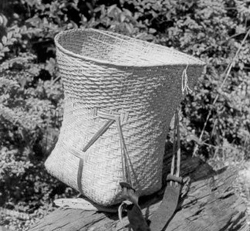
Sanville and Mathilde Johnson, a childless couple and the last surviving Choctaws in the Lacombe area, met Tom Colvin in 1963 while selling their baskets on the highway. Years before, Mathilde and her mother, Sally Lewis, would board the "New Camellia" steamboat to cross Pontchartrain, laden with their baskets, herbs and sassafras filé to sell at the French Market in New Orleans. The captain let them ride for free. In later years, women of the dwindling Choctaw enclave would peddle their baskets through the streets of nearby towns.
Mathilde agreed to give Colvin a chance to learn the intricate weaves she knew would otherwise die out with her and her husband. "Well, if you want to learn," she said to him, "you'll have to know how to gather materials first." This backbreaking labor constitutes two-thirds of the time necessary to complete a basket.
Colvin went into the swamps to gather the slender green palmetto stalks. True to the Indian theory of conservation, he took only a few stalks from each plant he found. Since each stalk yields only about five good strips to make into weaving straws, the task of gathering materials for even one small basket requires dogged determination.
After peeling the straws under Mathilde's supervision, Tom was taught the weaves. Says Tom, "You must discard the traditional concept of school, where you are taught in segmented steps. That's not the way the Indians go about it. Theirs is really a more natural way of going about things."
Over the years, Tom has completed most of the traditional baskets: the egg basket, the large pack basket worn on the back, the heart and elbow baskets which hung on the walls and stored utensils, sifters for sassafras leaves and cornmeal, fruit baskets, pocket baskets for storage, sewing baskets, button baskets, match baskets, and lidded lunch baskets. Tom occasionally gets the urge to tackle the most difficult weave of all, the double weave, which held valuables.
Though Colvin learned the art of mixing natural dyes from the yellow dock plant, red oak bark, black gum bark, mulberry, and walnuts, he now uses a commercial dye for his baskets. Colvin shows his baskets at regional craft fairs, though he sells but a few of them. He says of his craft, "I enjoy making baskets, because I know whatever my fingers are doing, that's what the old people's fingers were doing in the years past."
Though both Sanville and Mathilde are dead now, Tom maintains their tradition through his work, as well as through his publication, Cane and Palmetto Basketry of the Choctaw of St. Tammany Parish, which is a treasure of previously unrecorded Choctaw lore. More fulfilling than anything else, Tom says, is teaching his adopted skill. The culmination of his attempt to keep the Choctaw legacy alive came when a young member of the tribe, George Allen of the Jena band, came to him for instruction. "I was so glad to teach him, because what I learned from the Choctaw, I was able to give back to the Choctaw."
—Janice Dee Gilbert
Blacksmithing
Henri Vergez, Covington
Blacksmith Henri Vergez descends from French settlers; his speech remains flavored with the language of his forebears. His father came to Covington from France via Carencro in 1900. The elder Vergez bought a blacksmith shop on Jefferson at E. 25th Street, just across the street from where Henri's shop stands today. He built surreys, buggies, wagons, and dumpcarts for the booming industry of the time, and employed two workers who operated a horseshoe shop. Henri says with some pride that his father didn't actually shoe the animals himself, indicating that there must have been some sort of blacksmith hierarchy. When horseshoes were no longer needed, he opened up a corn mill. Henri still has the machine which ground Covingtonians' corn into meal.
Henri describes the old smithing process as an assembly-line affair. "First there was the steel forgeman, who beat and fired the iron; then there was the wheelwright, who fashioned the steel into shape. You can't have one without the other. My father could do both."
Henri inherited the skill. "I can do anything with a piece of iron," he boasts. These days his shop is open only a half-day, however. The shop stands on land his father was able to purchase from the city, when Jefferson Street was narrowed by fifty-four feet. Henri took over the blacksmith trade when his father had a stroke and died. "The shop had to be open on Monday, so there was nothing else for me to do."
Vergez specializes in ornamental cast iron these days. While he knows how to work the iron by hand, he rarely does it anymore. He speaks with pride of the old days, and of the special file of photos and exact specifications his daughter has made of every implement that he used to produce.
—Janice Dee Gilbert
Corn Shuck Weaving
Willie Mae Young, West Feliciana
Willie Mae Young never dreamed that her craft would become as popular as it did when it was publicly displayed at the St. Francisville Pilgrimage. She has demonstrated cornshuck weaving at the New Orleans Jazz and Heritage Festival, was asked to participate in a craft seminar at Texas Southern University, was featured on television, and has had her mats displayed in a California museum. Even with all of this demand and recognition, her children and grandchildren have not yet expressed a desire to learn the craft, although Ms. Young wishes they would. Her oldest grandchild, she claims, "is very smart; she would learn if she was around me enough."
Willie Mae Young, at one period in her life, supported herself totally by weaving cornshuck chair bottoms. Now, with a full-time job as a doctor's assistant at Angola Prison, she has less time to practice her craft, even though she gets many requests to exhibit her work.
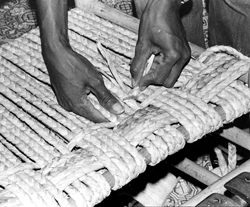
Willie Mae Young spoke to me about growing up a Black child, on Beulah Plantation in West Feliciana Parish, where both of her parents were also born and raised. She was one of fourteen children, eleven of whom are still living. Both of her parents worked in the fields and wove cornshucks, while her mother canned two to three hundred jars of food per year. Ms. Young's father fashioned cornshuck yokes. "He was the onliest person around here that could make those," she recalls. Her mother, who had learned how to weave cornshucks from her mother, worked on mats and chair bottoms at night and sold them to white people. Ms. Young started helping her mother at around age nine, and in a year or so she was making cornshuck items all by herself. She claims to be the only family member who still weaves mats or chair bottoms. However, her father's skill of making yokes was not passed down at all.
—Nancy Bernstein
Hides Tanning
Terry Quave, Madisonville
Terry Quave is a jack of all trades, descended from an old Spanish Cuevas family who first settled the parish. "I have a creative drive, I like to work with my hands," he says. "Great Grandpa Francois Anatol Quave tanned his own hides, made his own shoes and Lord knows what else. It seems like I inherited that trait." On his land just outside of town, Quave tans hides, makes arrowheads, and carves alligator bones.
When a neighbor is going to butcher a cow, he'll call Quave, who'll run over and help him skin the animal in return for its hide. Quave also strikes bargains with local deer hunters; he'll tan one hide for them and keep two for himself in payment. Occasionally, Terry also tans a mink or otter.
After salting down the hide for four days to harden the tissue, Quave fleshes it out with tools he invented himself. After a water soak relaxes the hide, it is immersed in a lime solution for several days to remove the hair and then neutralized with vinegar. The hide is then soaked in oxalic acid and salt pickle solution for two weeks. Next, it is put in a chromium alum solution for two more weeks, and then neutralized again, this time with bicarbonate of soda. Quave bark-tans the hide with a solution obtained from the quebracho tree of South America. Tanned hides are then fashioned into belts, moccasins, vests, and purses. The butter-soft leather is especially prized by Quave's friend Jim Moor of Folsom, who uses it to recreate authentic Indian costumes for ceremonial dances.
Another of Quave's crafts is carving alligator bone into knife handles and jewelry. He has a license from the Wildlife and Fisheries Department to keep and sell alligator bones. "The worst thing," he says, "is how some people will shoot 'gators and just let them lay. It's a total waste." Each time he sells a piece of bone carving, he must submit a report to Wildlife and Fisheries.
Terry Quave's yard and barn are filled with unusual materials: tortoise shells and snake skins, stones and bones. One day, he'll fashion each into something unique. "I do sell some things, but it seems like I get more pleasure just giving them away."
—Janice Dee Gilbert
Quilting
Gladys Wicker, Zachary
For many generations Black women in the South have made patchwork quilts for utilitarian purposes. Although quilt making is not a specifically African tradition, it is possible that both the tradition and styles of Black-American quilts are related to the African tradition of decorative textiles. Of course, decorative quilt art is not entirely a Black-American phenomenon, but the quilts of other cultures are often more formal and unyielding in design than the Afro-American examples.
In some areas of East Baton Rouge Parish, there is still a vital quilting tradition. In the community of Zachary, Mrs. Gladys Wicker is recognized as an excellent quilter. Born in Deerford on May 19, 1920, she has been quilting for about forty years. After marrying, she had seven children and "she had to start quilting to keep all of them warm."
Mrs. Wicker began quilting on her own, but she learned some basic techniques by observing her mother and other ladies in the neighborhood. She said, "I just started with pieces that were too small to make dresses, or clothes that were almost worn out." Mrs. Wicker used a quilting frame, but she stated that her family also used quilting horses, similar to the wooden horses that carpenters use.
Naming patterns is part of American quilt folklore. Some of the patterns that Mrs. Wicker has made are "Texas Lone Star," "Trip Around the World," "Grandma's Patchwork," and "Double Wedding Rings." However, the ties to West African textile art can be seen in the quilts that she refers to as string quilts. One of her favorite quilts is the "Texas Pine Burr" or "Sunburst" quilt, which took her six years to complete. She comments, "It's so heavy you sweat every time you sleep under it, even if it's freezing outside."
Mrs. Wicker never sells any of her quilts. She usually just makes them for herself and her family. She has sent her youngest daughter a few of her patterns, and now her daughter in Oakland, California, has started quilting.
Quilting used to be and still is quite a social event in Zachary. Twelve to fourteen elderly Black women get together every Tuesday at the Zachary center for their weekly quilting bee. Thus it is likely that quilting will survive in Zachary's Black community for quite a long time to come.
—Joyce Marie Jackson
Turlie Richardson and Lillie Payton, the Felicianas
Quilting is very popular among older women in East and West Feliciana. A visit to the West Feliciana Council on Aging reveals almost twenty women who call themselves regular quilters. This group works on a communal quilt at the council each day, eventually selling the finished quilts to local people or at the New Orleans Jazz and Heritage Festival. Most of the women learned quilting at home, where quilts were made as a matter of necessity. Turlie Richardson describes the "quiltings" she attended at her aunt's house as a girl: "We'd have quiltings then, you know . . . we'd sit there and quilt out sometimes two or three quilts a day. You see, two people would cook, and the rest of 'em would quilt. They'd be there singing and having fun quilting.
Later in the interview she elaborated on these quiltings:
Well, it'd be in the first of the fall, at that time, 'cause we would have a fire in the hearth, and peanuts and potatoes, you know, and my uncle would go and kill squirrels and coons and stuff like that—rabbits—and we'd be just cooking molasses and bread and maybe peanut candy, and stuff. Oh, we'd have a good time. You'd have five or six ladies who'd stay till first night, then their husbands would come get them.
She also described the materials used:
And we didn't know nothing about no quilt batts and stuff like now. We had scrap cotton from the fields, and then we'd put it down on the floor where we're gonna quilt and we'd get long switches and we'd whoop that cotton till it'd get like she (her aunt) wanted. Then we'd crawl around on us knees and pat it. Where she'd think it was too thick, we'd pick it. That's what we had to do.
Mrs. Richardson also described using meal, flour, and even fertilizer casks to make the backing for quilts. She said her aunt had devised a method using lye and Octagon soap to get the print off the fertilizer sacks.
Neither of the two white quilters interviewed had taken part in a quilting, while all of the Black quilters had. Perhaps, this indicates that quilting was for whites less a necessity and more of a pleasurable, personal hobby. The two Black quilters were not concerned with the names of patterns; Lilly Payton only recalled the name of one of the patterns she used, a "Bird's Trap," which resembled the traditional log cabin pattern. Many of their quilts were nine-patches in which long, solid panels of cloth divided strips of nine-patch squares.
Over the years, both Lilly Payton and Turlie Richardson had spent much of their free time quilting. As with the two white quilters interviewed, they expressed a pure and simple joy in the activity. Mrs. Payton explained:
Yes, I enjoy it. I just went head over heels with it. Looks like I'd rather do that than anything else I know of. I leave the house alone and do my quilting. That's what I just loved, I don't know why.
It is interesting to note that Mrs. Richardson, who began her quilting days using feed sacks and scrap cotton, has proved equally adaptable to contemporary materials. She likes to sew with synthetic, knit materials and often uses polyester batting, although she will use the more traditional cotton batting when it is on sale. Both women piece their quilts by machine (although Lilly Payton does her string quilts by hand) and quilt them on homemade frames suspended from the ceiling. Both have recently sold quilts for the first time, through contacts made by the local Council on Aging.
—Susan Garrett Davis
Wool Carding
Emma Clesi, Mandeville
Emma Clesi grew up in Boutte and Ama, Louisiana, and has lived in Mandeville for approximately thirty-five years. She grew up close to her grandmother, who had a farm and raised sheep, among other things. The grandmother used to sit in front of the fireplace in the sitting room and card the cleaned wool from her sheep. After helping her grandmother for many years, Mrs. Clesi remembers how to card wool, and she still has her grandmother's old cards.
When Mrs. Clesi was married, she and her husband moved to Mandeville and started an antique business. Her raised house, traditional to Louisiana, is still brimming with antiques and, while she is no longer officially in the business, she claims she is her own best customer. She was asked to demonstrate wool carding for the Horizons Festival, which is about the only time that she brings the cards out. The wool is difficult to find today, and the carding itself is very hard on the muscles of an eighty-one-year-old woman. Mrs. Clesi explains that the wool must be carded until smooth, without any lumps, and can then be used as batting for quilts or, as her grandmother did, made into double wool blankets.
Mrs. Clesi remembers growing up in Ama. "It wasn't a town, it was just a country place, just a couple houses." Life was peaceful and quiet. They rode horses and did a lot of walking. She calls them the good old days but insists that the present with all its modern conveniences is better.
—Nancy Bernstein
Foodways Traditions
Making Filé
Geneva Flot, Abita Springs

In contrast to the upscale residents and artists who have made Abita Springs their home, there is a tightly knit network of Blacks with a strong Indian heritage, much like that in the Lacombe area, who have never left their hometown. Black, Indian, and French Creole bloodlines have created this unique group of families. Says Ms. Geneva Flot (pronounced Flo) "They's been a few of them that left. But plenty of 'em come back!" There is more than a score of Flots in the phonebook, and lots of them live on Flot Road, named for an ancestor.
The Flots and other families like them stick close to their land, and to the old customs as well. One enduring family tradition is the making of filé powder for gumbo. Geneva learned the art from her mother, who learned it from hers, who learned it from hers. Every other year, the Flot family, old and young, goes into the woods in search of the sassafras tree from which the filé is made. While a few favorite spots still yield the sought-after fragrant leaves, like old Uncle Antione's place on Talisheek Road, it's getting harder and harder to obtain sassafras. "It's getting scarce, now. You can't hardly find it anywhere, you just got to hunt," says Geneva.
A pint jar of filé lasts just about two years, she explains, and this is fortunate, considering the hard work involved. First, there's the breaking of the branches. Old trees make the best filé. In August, when the leaves are still green, the younger generation breaks the boughs and brings them to Geneva's shed to dry. The branches remain in the dark for about three weeks, depending on the humidity or weather conditions. When the leaves are sufficiently dry, they are picked and put into a cotton or burlap sack. The sacks are spread out in the sun each day to dry further, usually for two or more weeks. When the leaves feel crumbly, they are ready to beat.
The beating, Geneva explains, takes place on the first cold day in October, when the family is all called together. The leaves are put in a mortar and pounded with an old wooden pestle, the kind that was used to break rice from its husk. Geneva guesses that it has been in the family for nearly 100 years. The leaves are beaten until pulverized. Next, they are sifted with a special sifter, designed by Geneva's brother. After the first sifting, the filé goes back to the mortar for another beating, and then a final sifting. Geneva would rather go hungry than use that store-bought filé in her gumbo. "They put bay leaves in it, you know," she sniffs.
Geneva also digs sassafras root on occasion. "My Mama would make a tea out of it. She said it was good for the high-blood. Maybe that's why she lived to be ninety-nine years old."
There's no chance that the filé will be sold commercially, because it's too hard to produce. Making it serves to tie the family together. "Tradition, you know," says Geneva. "As long as I'm able to see, sit, and sift, I'm going to keep on doing it."
—Janice Dee Gilbert
Traditional Occupations
Fishing and Harvesting Soft Shell Crabs
John Lebreton and Russell Glockner, Mandeville
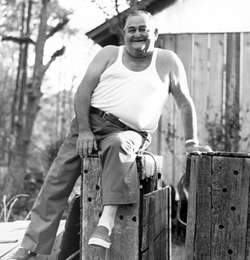
It is the proximity to the still bountiful Lake Pontchartrain that keeps the true native crafts of fishing and net making alive. There are many commercial fishermen in the Mandeville/Lewisburg area who supply fish and crab to local seafood outlets. Both John LeBreton and Russell Glockner have been fishing the lake since they were kids. Both still live on the same street where they were born. They have a sense of place and an affinity with the elements that is rare in St. Tammany's increasingly modern society. John LeBreton has been a lake fisherman for over sixty years. He describes lake crabbing as a constant process of "puttin' 'em down and pickin' 'em up." He says, "When you makin' soft crabs, you got to get up early and get out in the lake before the crabs get hard—they'll get hard in an hour's time." LeBreton looks for the "buster" crabs. A buster is one that has gotten so fat that he begins to bust his shell open, soon shedding it altogether. Then he becomes the aristocrat of crustaceans: the soft shell.
Catching the busters at just the right moment is an exact and tedious science. At sunup, LeBreton loads his homemade wire crab traps into his wooden skiff and noses out into the lake. After he baits the traps with fish and flings them overboard, Styrofoam balls branded with his fishing license number float to the top and mark off his territory.
After a sufficient pause, LeBreton harvests the catch. He pulls the traps up from the deep water and sorts the crabs into two compartments in the boat: one holds the "good" crabs, those that will shed, and another takes the hard ones that won't. LeBreton takes care not to mix good crabs with hard ones, because they'll fight each other. "You hear them cracking each other in the boat, busting one another's shells."
He brings the boat load of crabs into shallow water and begins classing them into floating wooden crab boxes. Classing the shedding crabs requires a seasoned eye, and a cautious hand. LeBreton first takes his pliers and nips the pincers off, then separates them into the boxes according to their developmental stages. Hard ones that will shed go into one box, "green" ones (those closer to shedding but not yet "ripe") go into another, while the busters who'll shed that day belong in a third container. (Hard crabs that won't ever shed go home to Mrs. LeBreton's gumbo).
Every day, LeBreton goes through the boxes, which are never disturbed by other crabbers and fishermen, to check on the shedding process. He isolates those about to vacate their shells; if they shed in a box of harder crabs, they'd be eaten by their box mates. And, at today's prices, LeBreton wants only paying customers to eat his soft-shells.
Both fishermen remember when the painstakingly nurtured soft shells were hard to sell. Says LeBreton, "You had to get out on the highway and hold them up, begging people to buy them for $1.50 a dozen, forty years ago."
Glockner recalls selling crabs to tourists aboard the trains, which ran from the lakeside wharves on up to Abita Springs and Covington. He would pack the live crabs in wet moss and stand by the tracks. "Between you and I, crabs kept longer in those days. They were saltier." He'd sell a dozen for 50 cents in 1931, thrusting the boxes to customers through the open train windows.
Traps have also changed through the years. Crabbers used to use drop flat nets which were picked up and checked with a long pole. Such nets had to be brought in every time the lake got rough. The modern trap, introduced some twenty-five years ago, is a chicken-wire contraption with tunnels that lead the crabs to a protected bait box. "Today," says LeBreton, "you have your traps out there indefinitely; they are working while you're sleeping, you see."
These first traps were galvanized, but now are made of plastic coated wire. LeBreton buys a roll of wire and makes his own, saying he can make them cheaper than the eight dollars they sell for in stores. Likewise, he makes his own boxes from red cedar and galvanized nails, boring holes in them to keep them afloat. He used to use cypress, until it got too expensive. Besides, he says, cypress tends to sink faster.
Both fishermen bemoan the ecological changes in the lake that have harmed the fishing industry. The opening of the spillway, mechanical trawlers, shell dredging, and chemical pollution have all taken their toll. And the very fact of increased growth on the north shore has added drainage and sewerage problems which adversely affect the lake. Residents are no longer able to swim in the water, and the times when people could catch their own dinner in the shallow, clear water is gone, maybe forever. But long-time pros like LeBreton and Glockner keep on because they love it, and because they know no other way of life.
—Janice Dee Gilbert
Traditional Farming
McCoy and Nora Berthelot, French Settlement
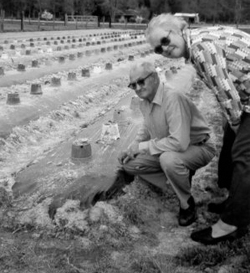
The southwestern part of Livingston Parish was settled by many different groups, but the dominant language until the 1940s was French. Nevertheless, many of the French-speaking residents do not consider themselves Cajun, but rather an ethnic mix. Both McCoy and Nora Berthelot of French Settlement are of French, Irish, and German ancestry, while Nora also has some Italian antecedents. Their first language was French, and both learned English when they started school.
Since McCoy's retirement as a schoolteacher, the Berthelot's income is partially earned by selling dried peppers. Berthelot's mother grew peppers for family use. When she died, the couple started growing their own and they gradually began to sell them as well. The seed is the same species that his mother saved, though Berthelot has not identified the exact variety.
The peppers ripen on the bush and are then picked, washed, and placed on trays in a humidity-controlled drying shed. Previously, the Berthelots dried the peppers in the sun as McCoy's mother did, but government regulations now prohibit open-air drying. Once the peppers are dry, Nora grinds and bottles them. When word spreads that the peppers are ready, they are deluged with phone calls.
The Berthelots also dry sassafras leaves for gumbo filé. Very few wild sassafras trees remain, but friends bring leaves from trees in their yards. The leaves dry and are ground in one day. McCoy keeps half for toll or payment.
The Berthelots sell as much pepper and gumbo filé as they dry, but they prefer to keep their operation small. McCoy says, "I do it mostly as a pastime and to have some for ourselves and friends. I give away some. . . . I got to get along with people."
This sense of obligation permeates the Berthelots' lives. An unstated rule within their community is to share any abundance with others. Families routinely plant much more of a crop than they can use, and give the surplus to others in the community. This is not a formal exchange with strict accounting, but rather an informal arrangement that pleases and benefits all. Virtually all of the older and many of the younger people participate, but as more people work at outside jobs and stop gardening or raising animals, such activity unfortunately diminishes.
The boucherie works on this same principle of exchange. Participants raise their own hogs but share the work of slaughtering. The Berthelots—who have owned up to 600 hogs at one time—also own the coolers, saws, grinders, and other equipment used to slaughter hogs, smoke meat, and make pork sausage. The boucherie becomes a periodic party for all the families involved. The family that brings the hog keeps the meat, but pays everyone back with labor at another time. If family members are only using some of the equipment, they may bring a hamper of peas, sweet potatoes, or a basket of eggs, if they have an abundance at that time. If not, they will bring something later.
—Maida Owens
Ozzie Mae and J. D. Warner, Franklinton
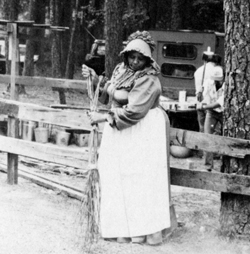
Ozzie Mae and J. D. Warner live just north of Franklinton, near the Mississippi line and are Black. Mrs. Warner makes lye soap at the Washington Parish Fair. She was visiting a friend at the hospital and was expected home shortly, so Mr. Warner immediately sat us down and insisted that he fix us first coffee, then a lunch of homemade sausage and iced tea.
After lunch, Mr. Warner took us on a tour of their forty-acre farmstead. He began with an old log house, which they had moved onto their property some years ago after a friend had expressed desire to be rid of it. The log house, which consists of only two small rooms, is filled with old furniture and household goods. To Mr. Warner, this house is the epitome of traditional living, and everything in it, he claims, is over one hundred years old. When visitors come to see what traditional life is like, the Warners show them the log house, treat them to homemade biscuits, and demonstrate old implements, like the cornshuck broom.
Ironically, the really traditional lifestyle surrounds such visitors, and is not limited to an old house filled with battered paraphernalia that is probably not all one-hundred years old. The Warners live a traditional lifestyle on forty acres of land. They have gardens which supply them with produce throughout the year, as well as chickens, hogs, sheep, goats, and cattle. Mr. Warner retired from his job as a cement layer some years ago and is happy that he can now devote all of his time to the farm's upkeep.
The farm sprawls back from the road. The house was obviously built in more than one stage, and numerous small buildings or shacks crowd the area in between the house and the fields. One of these buildings is the smokehouse, where, when we visited, parts of three hogs were hanging, well preserved. Mr. Warner explained that the meat was soaked in salt water before the smoking process, so that it was really doubly preserved. At times people visit and try to buy the smoked pork, and Mr. Warner sometimes complies, but he prefers to make sure that the family is well supplied for the year.
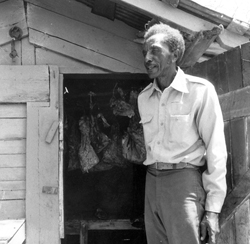
On our way back from the tour of the grounds, Mrs. Warner arrived home. She declared she was sorry that she had not had time to dress in her traditional clothes, since she had been called away to the hospital. She apparently enjoys putting on a show for her visitors, just as she enjoys her lye-soap making demonstrations at the Mile Branch Settlement.
Ozzie Mae Warner has lived in Washington Parish all her life, just as her parents did. Her family farmed, and her grandmother lived with the family. The grandmother, as is so often the case, taught Mrs. Warner most of her traditional skills, including making lye soap, lye hominy, and various healing arts. While we were talking outside her house, some people drove up the driveway and took Mrs. Warner aside. She later explained that they had come for a remedy, but she did not go into the matter further.
Mrs. Warner makes lye soap at least once a year, for the Washington Parish Fair, or whenever someone requests a demonstration. She sells the soap, but always has some in store for her personal use. She claims it is a cure-all. It will heal poison ivy, bee stings, ant bites, acne, and more. She even has stories to substantiate her claim. During the Washington Parish Fair, children come to her to be washed with lye soap when they get stung or encounter poison ivy. And each time they go away satisfied.
To make the lye soap, one begins with the basic ingredients: lard, lye, and water. The necessary tools include large kettles, a paddle (wooden), porcelain molding pans, wax paper, and slow-burning wood. The temperature under the simmering soap must be watched carefully to keep the mixture from boiling over. Mrs. Warner says that lye-soap making is a sensitive process that one must learn over time. When the soap is finished cooking, she pours it into the molding pans, where it sets until firm. Then she cuts the soap into large blocks (approximately 2" x 1" x 4"). The soap has an earthy, clean, and fresh scent that makes Mrs. Warner's stories easy to believe.
—Nancy Bernstein
Shrimping, Farming, and Trapping
Allen Wall, Springfield
Allen Wall combines the traditional occupations of trapping, shrimping, and strawberry farming. He believes it would be difficult to survive on only one of these occupations, but by doing all three he is able to retain a freedom in his life which he values highly.
Allen Wall was raised on a strawberry farm near Springfield. His parents were of Irish and French ancestry and spoke English only. When Wall finished school, he did not want to farm, but as he relates, "It only took two years to find out (farming) wasn't as bad as I thought. I like the freedom. . . .You do what you want or work as hard as you want, and you get out what you put in."
Wall is able to pursue his diverse trades because strawberry farming, trapping, and shrimping fall in different seasons. The strawberries are planted in the fall but require little attention until spring. Trapping season runs from December through February, just when the strawberries start needing work. Berries are picked in spring, and shrimping begins in summer. He traps alligators in September.
With 150,000 strawberry plants growing on fifteen acres, Wall's farm is one of the largest in his district, and he has stayed current with agricultural practices. Similarly, with 120 dozen traps on 10,000 acres leased in Blind River swamp, he also has one of the region's largest trapping operations, and his methods differ little from traditional ways.
A trapper's primary problems are covering large distances and carrying heavy pelts out of the swamp. Traditionally a trapper walks or pushes a pirogue. Allen Wall, however, now uses an airboat. He explains that if trapping is a person's primary occupation, efficiency dictates that he must cover large distances quickly. "If I pick up three nutria in thirty-five miles in one day, that's a day's work if I have a price for it." The large boat also allows him to pick up many more pelts in one trip.
Besides the use of airboats, trapping has changed little. Nutria is still the most sought after animal. There are so few mink, otter, and raccoon that without the nutria, a trapper could not make any profit.
The trapper skins the animals as soon as possible, leaving the carcasses for scavenger species. He then stretches and dries the pelts. The skill with which a trapper handles the skins (along with the health and size of the animal) determines the price the pelts will bring.
For the Wall family, shrimping is a working vacation with the entire family working the boat. Family members catch an adequate supply for themselves and friends, while selling enough to pay expenses.
—Maida Owens
Religious Customs
Pentecostal Experiences
Maudie Simeon, Livingston
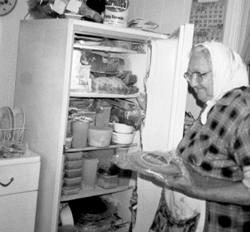
Maudie Simeon describes herself as Anglo-Scotch-Irish or "just American." At her home near the town of Livingston, Simeon maintains a large garden that she works completely by hand. The garden provides most of her food and plenty to give away. Simeon grows grapes, pears, peaches, figs, and persimmons; until recently several beehives provided honey. She occasionally cooks on a wood stove and splits all her own stove wood.
Maudie Simeon is a member of the Pentecostal or Holiness Church. She explains that she has "got the Holy Ghost. When you get the Holy Ghost, you'll speak in tongues. That is the sign. It's just like when you bought your shoes. You got your shoes and the tongues come with it." When praying, if one "gets close enough to the Lord, [speaking in tongues] will come out."
Simeon is also fond of quoting scripture. For example, Maudie believes since Jesus was baptized in a river, people should do the same. A common site for Holiness baptisms is the Tickfaw River on U.S. 190 near Holden.
The Holiness Church believes in divine healing without the use of conventional medicine. Simeon explains, "I do know one thing. There's people living close enough to God and got enough of God in them that they can pray for you, and God heals you through their prayers." The healer, who is not necessarily a minister, "puts olive oil on your forehead and prays, ‘In the Name of Jesus, receive your healing' or ‘I command this devil to go' (if possession is suspected). If they are living right, it will happen."
Maudie describes the church service as "all Bible. They don't add to it or take any away." She sums up her religious beliefs by saying, "If it ain't in the Bible, I don't believe it."
—Maida Owens
St. Joseph Altars
St. Joseph Altar, Baton Rouge
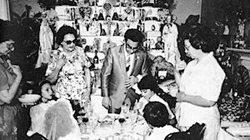
Large numbers of Italians came to Baton Rouge around the turn of the century. One of the most distinctive folk traditions that they brought with them is the St. Joseph altar. St. Joseph, the patron saint of Sicily, is described as a hard worker who did not seek prestige or reward. A person promises to make an altar if a favor is granted. The favor usually concerns a life or death situation, or asking the return of a son from a war.
An altar can be promised in any way at any time to any saint, but most commonly a person promises to make an altar on or near St. Joseph's Day, March 19. Most people promise to pay for the altars' construction themselves. To promise to beg for all of the food, however, is considered an even larger sacrifice. Some families in Baton Rouge have made altars annually for the past thirty or forty years, while others make them every five years. For smaller favors granted, people promise to contribute to someone else's altar. Thus, the person who promises not to solicit donations cannot refuse voluntary donations. To do so would deny someone else the opportunity to fulfill a promise to St. Joseph (see also Customs, Traditions, and Folklore of a Rural Southern Italian-American Community).
Until the 1950s and 1960s, the tradition of making altars was very strong in Baton Rouge. But in the late 1960s and 1970s, only a handful of altars was made. In 1978, the Grandsons of Italy began building a community altar to revive the tradition and stimulate ethnic pride among the young people. The altar of the Grandsons of Italy has a different purpose than the family altars. In order to promote public awareness and encourage large numbers of people to participate, the altar is a group effort without any individual cause. Much larger than a family altar, these community efforts feed approximately 3,000 people. The fresh fruit and vegetables are given to local charities. The community participates, the bishop performs mass, and political leaders attend. But the altar itself has all the elements of a home altar, such as cookies and breads in traditional shapes.
The Grandsons of Italy have succeeded in stopping the tradition from dying. Every year more and more families are making their own altars in the traditional manner, for traditional reasons. They are aided and encouraged by older people in the community who are familiar with the procedure and customs.
Just as the tradition spread from Sicily to other parts of Italy and the United States, the tradition is spreading among non-Sicilian Catholics in Baton Rouge. Catholics of all backgrounds, including Blacks, are making altars today.
Bootie and Leroy Landry made a family altar in 1984 because they both had cancer. Bootie, who is half-Italian, was not doing well after chemotherapy and a friend suggested promising an altar to St. Joseph. Bootie said, "I wouldn't know how to begin . . . and she said, ‘Don't you worry about it. [We] will get together and we'll all help you. You can have that [altar]. You offer it up to Jesus, Mary, and Joseph and they'll help you.'"
The tiered altar was covered with white cloth at one end of a room from floor to ceiling. In front of the altar was the Saint's Table, which had place settings for as many saints as promised. An altar has at least Jesus, Mary, and Joseph, but some have had as many as eight to twelve saints. In the room stood a table with St. Joseph prayer cards and fava beans. Both are for good luck and are carried in a purse or wallet throughout the year.
Since St. Joseph's Day falls during the Lenten season, all types of foods except meat were prepared for the altar. Fresh flowers, St. Joseph candles, a statue of the saint, and decorations such as hand-painted eggs were interspersed between fresh fruits and vegetables, cooked vegetables, desserts, seafood, and breads.
Several traditional items were included. Centered on the altar was a picture of Jesus, Mary, and Joseph with lilies beside it. Six fig cakes—in the shape of the crucifix, the staff of St. Joseph, the bleeding heart of Jesus, the chalice for communion, the ceborium holding the host, and the palm—were prominently displayed. Breads in the shape of the letters J (Jesus), M (Mary), and J (Joseph), and wreaths for each saint were obligatorily included. Cakes were decorated with praying hands, as open Bibles, lambs, or crucifixes. Other sweets included were Italian cookies, candies, pies, and pastries. Savory dishes such as stuffed peppers, artichokes, eggplants, fritters, quiche, and fried catfish also appeared.
The Saints' table is set for as many saints as promised; in this case St. Jude was included with the obligatory Mary, Joseph, and Jesus. A large redfish, wine, water, and baskets carved from oranges were on the table. A priest came to bless the finished altar the evening before, and afterwards visitors came to view the altar. Cookies and wine were served, but nothing was taken from the altar until after the Saints' Meal the next day. In the past, the family and visitors would pray and sing all night, but this practice has been largely discontinued by many families. Bishop Stanley Ott heard about this altar and surprised the Landrys by coming to bless the altar himself.
—Maida Owens
Toussaint (All Saints Day)
Toussaint, Lacombe
The sense of family tradition is strong in this small community, where almost everyone knows everyone else. Most residents, in fact, are related somewhere along the line. An annual symbol of this kinship is the lighting of graveside candles in the small private cemeteries scattered across the pine woods on All Saints' Day, November 1. On that day, community women prepare the graves for the evening ceremony. Fresh sand is spread, and the candles are set out around the gravesites to be lit at twilight. At that time the parish priest begins his trek from cemetery to cemetery, carrying on the old French custom of blessing the graves. As the women work, threads of family history are interwoven with complaints about the quality of the sand in this yard ("We could only get the grey, river sand!"), and exclamations on the beauty and abundance of the flowers.
With skin tones ranging from glowing copper and rich mahogany to a creamy café au lait, these women give visual credence to the historical data which suggests that Lacombe, first settled by the Acolapissa Indian tribe, was a refuge for runaway Black slaves from New Orleans. The Indian, Black, French, and Spanish cultures have mingled over the centuries, creating a beautiful, dusky population whose speech retains a distinctive patois. In the village's six page section in the parish telephone directory, the Batists and Cousins (Coozan) far outnumber the Joneses, and there are far as many Ducres as there are Smiths.
Though the eerie spectacle of the candles in the darkness has been somewhat of a tourist attraction, local families welcome the visitors. There is a sense of pride in continuing the old ways, as well as a sense of obligation to honor the dead.
As one woman, sweating from exertion, put it, "I'm getting too old to be doing this. But, as long as I can make it, I'll come out to dress the graves. I bring my grandchildren with me, so that after I'm gone, they'll do the same for me."
—Janice Dee Gilbert


